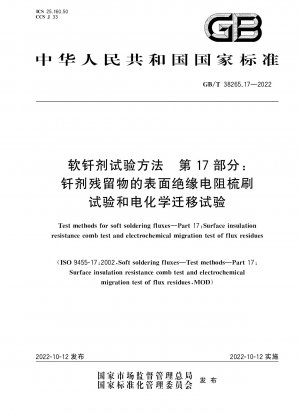GB/T 38265.17-2022
Test methods for soft soldering fluxes—Part 17: Surface insulation resistance comb test and electrochemical migration test of flux residues (English Version)
- Standard No.
- GB/T 38265.17-2022
- Language
- Chinese, Available in English version
- Release Date
- 2022
- Published By
- General Administration of Quality Supervision, Inspection and Quarantine of the People‘s Republic of China
- Latest
- GB/T 38265.17-2022
- Scope
- This document specifies the test methods for surface insulation resistance and electrochemical migration of flux residues on the surface of test pieces after soldering, including principles, reagents, equipment, test board inspection, sample preparation, test procedures, evaluation, Precision, test report, etc. This document applies to Type 1 and Type 2 solder fluxes defined in GB/T 15829. The solder fluxes are in solid, liquid, or other forms such as cored solder, preformed solder, solder paste, etc.
GB/T 38265.17-2022 Referenced Document
- GB/T 11415 Laboratory sintered(fritted) filters--Porosity grading, classification and designation
- GB/T 20422 Lead-free solders
- GB/T 3131 Tin-lead solder
- GB/T 41104.1 Solder wire, solid and flux cored—Specification and test methods—Part 1: Classification and performance requirements
- GB/T 6379.2 Accuracy(trueness and precision)of measurement methods and results-Part 2:Basic method for the determination of repeatability and reproducibility of a standard measurement method
- HG/T 2892 Chemical reagent isopropyl alcohol
- IEC 61249-2-7:2002 Materials for printed boards and other interconnecting structures - Part 2-7: Reinforced base materials clad and unclad; Epoxide woven E-glass laminated sheet of defined flammability (vertical burning test), copper-clad
GB/T 38265.17-2022 history
- 2022 GB/T 38265.17-2022 Test methods for soft soldering fluxes—Part 17: Surface insulation resistance comb test and electrochemical migration test of flux residues

GB/T 38265.17-2022 -All Parts
GB/T 38265.1-2019 Test methods for soft soldering fluxes—Part 1:Determination of non-volatile matter—Gravimetric method
GB/T 38265.10-2019 Test methods for soft soldering fluxes—Part 10:Flux efficacy test—Solder spread method
GB/T 38265.11-2021 Test methods for soft soldering fluxes—Part 11: Solubility of flux residues
GB/T 38265.13-2021 Test methods for soft soldering fluxes—Part 13: Determination of flux spattering
GB/T 38265.14-2021 Test methods for soft soldering fluxes—Part 14: Assessment of tackiness of flux residues
GB/T 38265.15-2021 Test methods for soft soldering fluxes—Part 15: Copper corrosion test
GB/T 38265.16-2019 Test methods for soft soldering fluxes—Part 16:Flux efficacy test—Wetting balance method
GB/T 38265.17-2022 Test methods for soft soldering fluxes—Part 17: Surface insulation resistance comb test and electrochemical migration test of flux residues
GB/T 38265.2-2019 Test methods for soft soldering fluxes—Part 2: Determination of non-volatile matter—Ebulliometric method
GB/T 38265.3-2022 Test methods for soft soldering fluxes—Part 3:Determination of acid value—Potentiometric and visual titration methods
GB/T 38265.5-2021 Test methods for soft soldering fluxes—Part 5: Copper mirror test
GB/T 38265.6-2022 Test methods for soft soldering fluxes—Part 6: Determination of halide(excluding fluoride)content
GB/T 38265.8-2022 Test methods for soft soldering fluxes—Part 8: Determination of zinc content
GB/T 38265.9-2022 Test methods for soft soldering fluxes—Part 9: Determination of ammonia content